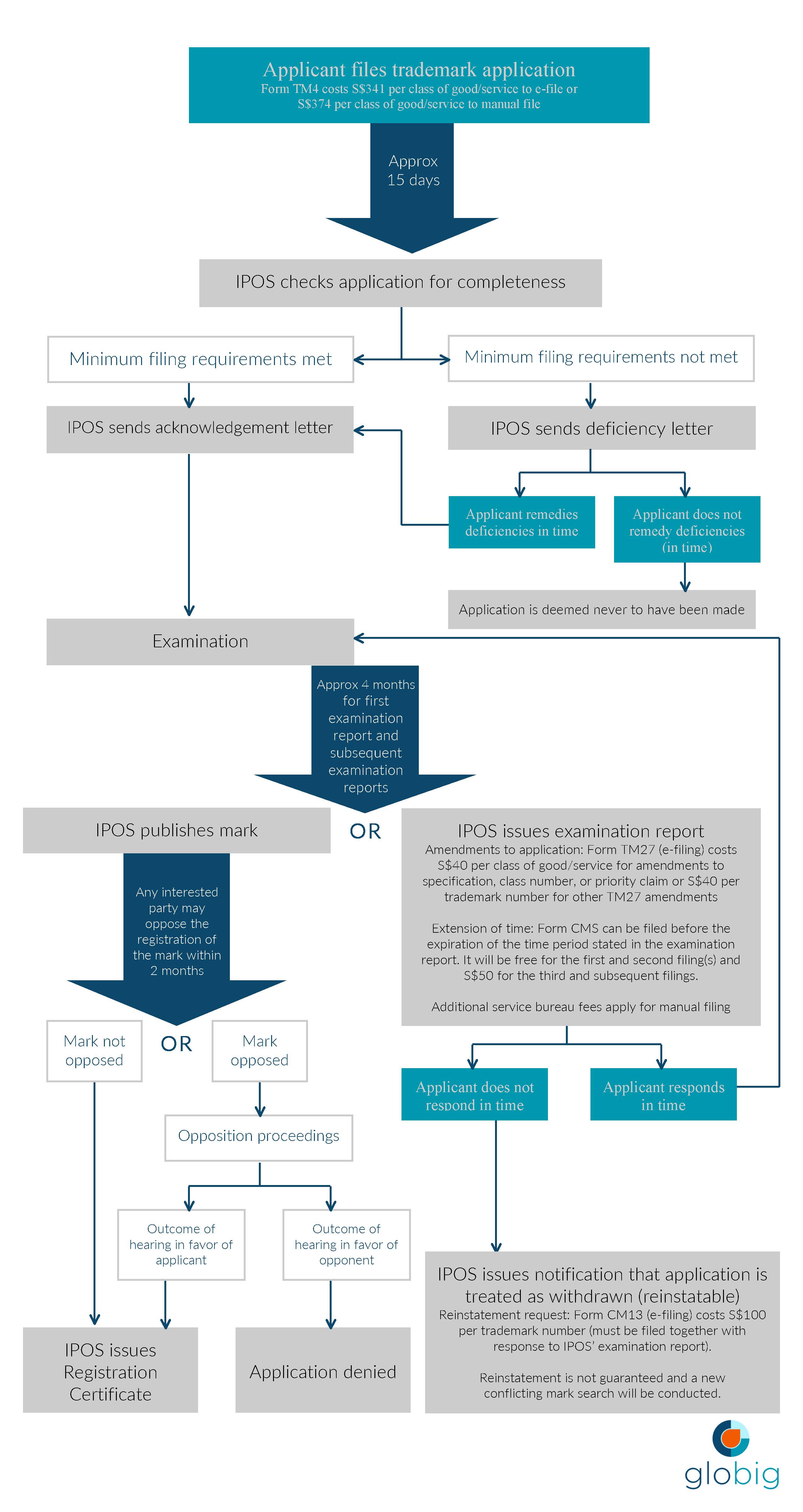
KNOWLEDGE BASE International Trademark in Singapore
The information on this page was current at the time it was published. Regulations, trends, statistics, and other information are constantly changing. While we strive to update our Knowledge Base, we strongly suggest you use these pages as a general guide and be sure to verify any regulations, statistics, guidelines, or other information that are important to your efforts.
International Trademark in Singapore
A trademark is a type of protected intellectual property and is considered an important intangible business asset. Acquiring a trademark can give your business partners and investors more confidence in your business, which can help you to collaborate with more partners and to raise equity to further develop your business. A trademark not only protects your creations, but can also maximize the value of your creation because you have the ability to license it out to a franchisee or sell it outright.
What is a trademark?
A trademark is a sign or mark that you can use to identify and distinguish your company’s goods or services from another company’s goods or services. By registering your trademark, you can prevent others from using its name or logo. Once a trademark has been registered, it is protected indefinitely as long as you renew it every 10 years.
What law or regulations apply?
The Trade Marks Act, Trade Marks Rules, Trade Marks (International Registration) Rules, and Trade Marks (Border Enforcement Measures) Rules regulate the registration, licensing, rights, renewal, and enforcement of trademarks in Singapore. In Singapore you are not required to register your trademark. If you have a mark that is not registered, you may rely on your rights under the common law act of “passing off” to protect your mark against imitation or infringement. However, if you choose to register your trademark, you will effectively gain a statutory monopoly on your mark. That is, your trademark will be legally protected from imitation and infringement.
Singapore follows the international classification of goods and services, under the Nice Agreement, to classify trademark registrations. The Nice Classification (NCL) sets out 34 different classes of goods and 11 different classes of services for the registration of trademarks. The following can be registered as a trademark as long as the mark is distinctive and your goods or services are capable of being distinguished from similar goods or services of other companies:
-
letters
-
words
-
names
-
signatures
-
labels
-
devices
-
tickets
-
shapes
-
colors
The following are some common examples of marks that cannot be registered as a trademark:
-
descriptive marks (e.g., super, best, cheap, one dozen)
-
marks that are common to your trade (i.e., marks that have become well accepted in relation to your trade and that do not distinguish your goods or services)
-
marks that could offend people or promote immoral behavior
-
deceptive marks (i.e., marks that misrepresent the nature, quality, or geographical origin of your goods or services)
-
marks that are identical to earlier marks
-
marks that could cause confusion (i.e., similar or identical to an earlier mark that relates to a similar or identical good or service provided by the owner of the earlier mark)
-
marks that are similar or identical to a Well Known Mark
Once you have successfully registered your trademark you are permitted to use the ® symbol next to your mark. Another common symbol associated with trademark is ™. This symbol denotes that the mark is being used by a company as its trademark, but it does not mean the trademark is registered or protected under trademark law.
Note: the trademark application process differs depending on where you are registering your trademark, i.e., in Singapore or outside Singapore.

In the Trade Marks & Patents section of Globig's Singapore Expansion Plan, you'll find information and steps to apply for a trademark in Singapore as well as an international trademark. The Singapore Expansion Plan also provides information, resources and step-by-step guides on a number of additional areas to help you with your expansion into the Singapore market.Talk to us about creating your Global Expansion Plan on hello@globig.co Today.
Applying to register a trademark in Singapore
![]() Although you are not required to file your trademark application through an agent, you may wish to appoint an agent to act on your (your company’s) behalf. Because every company has different needs and because the trademark process can be complex and lengthy, we recommend that you speak with an attorney about the scope of your rights.
Although you are not required to file your trademark application through an agent, you may wish to appoint an agent to act on your (your company’s) behalf. Because every company has different needs and because the trademark process can be complex and lengthy, we recommend that you speak with an attorney about the scope of your rights.
Before You Apply
-
Determine the classification of your goods or services. You are required to state the exact class number and appropriate specification according to the NCL. You can use the International Classification of Goods and Services Autochecker tool, found here with a user guide, to search for and classify your goods or services.
When to Register
There is no time limit for the registration of your trademark, in fact, you may have been using your logo in conjunction with the ™ symbol (or even without the symbol) for some time. One benefit of registering your trademark is that you can only file an infringement suit on a registered trademark. The effective registration date for your trademark is the date you file your application. In Singapore there is a priority claim procedure for in place for applicants who have filed an earlier claim for the same mark in a Paris Convention country or a World Trade Organization member country (other than Singapore).
You are permitted to file for several classes of goods or services within the same application. In order to obtain an official filing date, your application must include all of the following:
-
a statement that you request registration
-
your name and address
-
a clear graphical representation of your mark. For a mark that contains a three-dimensional shape of the goods or packaging, line drawings should clearly show all dimensions of the mark
-
a list of goods and services that you are registering in relation to the mark with their classification according to the International Classification of Goods and Services
-
a declaration of your proposed use of the trademark, and
-
appropriate payment of all fees.
Processing Time
Your application will generally be reviewed in about four months and you will be notified in writing if you application is in order for acceptance and publication or if there are any objections affecting your application.
![]()
If your application is refused, you must be represented by a local attorney and provide a local Singapore address for service.
Singapore Trademark Application Process Flowchart
Trademark protection term and renewal
If your trademark application is successful, your trademark will be valid and protected for 10 years from the initial filing date. Your trademark can however be protected indefinitely, so long as you pay the appropriate renewal fee at the end of the 10-year period.
International trademark protection
For international trademark protection, you can either file an application in each country in which you wish to have your trademark protected or you can register your trademark internationally through the Madrid Protocol. The Madrid System allows you to file one application in a single office (in Switzerland) in one language with one fee (in Swiss Francs) to protect your trademark in up to 95 member countries.
If you decide to file your application internationally, you must first register or file an application in your “home” office, in this case Singapore. You must be a resident or national of Singapore (or have a real and effective industrial or commercial establishment in Singapore) to use the Madrid Protocol to register your trademark across multiple countries.Then you will need to submit your international application with the International Bureau of the World Intellectual Property Organization (WIPO). Details of your application in the Madrid System will be sent to the IP offices in each country you wish to have your trademark protected. The countries in which you seek to register your trademark must be Madrid Protocol member countries. Each country will make a decision in accordance with their legislation (in Singapore this process will be very similar to the application process explained above) and record their decision with the WIPO.
The international registration of your trademark is valid for 10 years and can be renewed at the end of each 10-year period directly through the WIPO.
What are the risks of noncompliance?
If you discover that your trademark has been used without your consent, you may exercise your rights under the Trade Marks Act. In an action for infringement of a registered trademark by the proprietor of the trademark, the court may grant the following types of relief:
-
an injunction;
-
monetary damages;
-
an account of profits; and
-
in a case where subsection 5 applies (counterfeit trademark), the imposition of statutory damages.
In certain circumstances, the court can also order the erasure, disposal, or delivery up of the infringing goods.

Trade Marks (International Registration) Rules
Trade Marks (Border Enforcement Measures) Rules
Nice Classification (NCL)
International Classification of Goods and Services Autochecker
World Trade Organization (WTO)
Intellectual Property Office of Singapore (IPOS)
Intellectual Property Office of Singapore (IPOS) e-Services
Singapore Trademark Forms and Fees
KNOWLEDGE BASE International Trademark in Singapore

